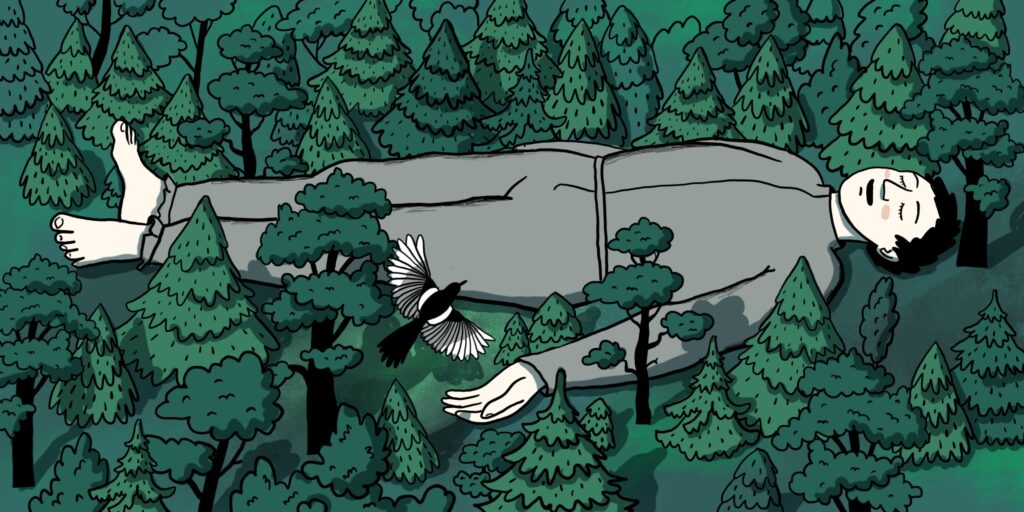Stress, overwork and burnout are experienced by people all over the world, but the Japanese seem to suffer from these problems particularly hard. In a safe and economically developed country, the level suicides. And to denote death from overwork and nervous tension, Japanese even has a separate word – karoshi. That’s why they take mental well-being seriously here and are constantly looking for new ways to deal with stress. One of them is shinrin-yoku.
What is shinrin-yoku
Shinrin-yoku is a Japanese practice of meditative walks in the forest. Term came up with in 1982 at the Japanese Ministry of Agriculture. Literally, shinrin-yoku can be translated as “forest baths.” The agency encouraged residents to use the practice to reduce stress and improve health.
Unlike a regular outing into nature, shinrin-yoku involves mindfulness and the inclusion of all senses while walking. Such unity with the environment should help restore strength and find inner harmony. The idea of shinrin-yoku corresponds to the tenets of Shintoism and Buddhism, the two main religions in Japan. In both, the forest is considered a sacred place, and the connection between man and nature is inextricable.
Shinrin-yoku is now part of Japan’s national health care program. In the country exists There are more than 60 certified places for walks and there is a forest therapy society that popularizes such walks.
What are the benefits of shinrin-yoku
Shinrin-yoku may seem like an esoteric practice. But since the 90s, in Japan and other countries, scientists have been actively studying the effect of “forest baths” on the body. In 2021, a group of researchers from Italy appreciated existing reviews on the topic and came to the conclusion that shinrin-yoku has a positive effect on the psychophysical state and quality of life. At the same time, the authors emphasize that walks in the forest are good as an additional practice, but it is impossible to say that with their help it will be possible to completely cure any disease.
How exactly does shinrin-yoku affect health? Firstly, in the short term, forest baths reduce cortisol and adrenaline levels, heart rate And arterial pressure, and also increase the activity of the parasympathetic nervous system. All this helps reduce anxiety and stress and alleviates cardiovascular diseases and depression.
Secondly, during a walk we inhale phytoncides – biologically active substances secreted by plants. This helps strengthen the immune system. Japanese scientists found outthat after a three-day trip to the forest, the number of natural killer cells – cells that protect the body from infectious and oncological diseases – increased by 50% in the blood of the subjects.
Thirdly, even short observation of plants improves attention and concentration. About it write Australian scientists who compared test results in two teenage groups. The first, during a 40-second break, looked out of the window at the concrete roofs, and the second, at the roofs with green spaces. Its participants made fewer mistakes.
Fourth, shinrin-yoku can improve the quality of sleep. In a 2005 study, subjects with sleep complaints notedthat after two-hour walks in the forest they began to sleep longer and more soundly.
How to Practice Shinrin-Yoku
This does not require special skills or special training. But in order for your visit to the forest to bring maximum benefit, we advise you to follow simple rules.
Find a suitable location
There is no need to go into an impenetrable thicket far from civilization. Explore the green areas closest to you; even a park within the city will do. The main thing is that the place is quiet and with clean air, away from roads and crowds of people. Make sure the area has easily accessible trails. It is unlikely that you will be able to relax while making your way through dense thickets.
Choose a convenient time
British scientists considerthat to improve your well-being, it is enough to spend 120 minutes a week in nature. They can be broken down any way you like and fit into any schedule. For example, walk for 20 minutes every day or go to the forest for a couple of hours on weekends. Find a time when you can put things aside and enjoy nature without rushing.
Don’t forget about safety
The forest can be not only a place of power, but also a breeding ground for ticks. So wear covered clothing when walking and use repellent. Do not neglect other safety rules: do not go deep into the forest, especially alone; do not linger until dark; check in advance whether the phone is charged; If you plan to walk for a long time, take drinking water and a snack with you.
Put down your gadgets
Before going for a walk, put your phone on silent mode and try not to take it out even to take a photo. It is also better to avoid listening to music on headphones. All this will greatly distract from the process and will not allow you to fully experience the atmosphere of the forest.
Do not hurry
Shinrin-yoku is not a physical exercise, but rather a meditation. The distance you travel doesn’t matter. So take your time and walk slowly, listening to your body. Although during shinrin-yoku it is not even necessary to constantly move, you can simply stand or sit in one place.
Focus on sensations
Use all your senses while walking. First, look around, noticing small details. Look closely at the pattern of the bark, watch how the light breaks through the crowns. Inhale slowly and deeply through your nose, enjoying the aroma of trees and flowers. Listen carefully to the sounds of the forest: the singing of birds, the rustling of leaves and grass, the murmur of the river. Feel the sun warming your skin, touch the leaves and hold branches and stones in your hands. Try to let go of all thoughts and focus on your feelings.
More Japanese interesting things 🎎🎏🎐
